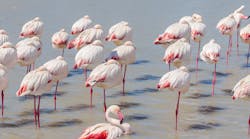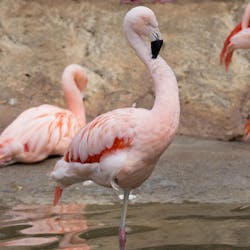Researchers at Emory University and Georgia Tech were curious as to why Flamingos stand (and sleep) on one leg. Some unproven theories suggested that it was to conserve body heat or to avoid muscle fatigue. So they began an in-depth study, eventually discovering the major benefit of the one-legged pose: It reduces the muscular effort the bird must exert. The research team hopes that with further study, their findings will help improve robotics, orthopedic braces, and artificial limbs, and lead to more focused treatments for neurological or balance problems in humans.
To get to their findings, the scientists studied live birds at the Zoo Atlanta flock, one of the largest breeding flocks of Chilean flamingos in the U.S. They also used two cadaver birds from the Birmingham Zoo and flamingo skeletons from the University of California at Berkeley’s Museum of Paleontology. (No birds were killed or harmed for the study.)
Their research revealed that a “passively engaged gravitational stay apparatus” helps the birds support their weight and maintain balance while on one reed-thin leg. The bird’s specialized anatomy, clever posture, and gravity combine to give the flamingo this ability, which does not involve bones locking into position. It’s more like a hammock or sling than a lock, but it does require the unique anatomy of flamingos. The “passively engaged” part of the flamingo’s gravitational stay apparatus functions exactly as described: It requires little, if any, active muscular or nerve control.
“The biomechanics are such that when they stand on one leg, they become very stable and are able to maintain that posture without activating muscle,” says one researcher. “If they deviate from that posture to two legs, that no longer holds. It’s very posture-specific, a one-legged posture that can support their body weight.”
Most people would be surprised to learn that the “joint” in the middle of the flamingo’s leg is actually an ankle, not a knee. The knee and hip joints are not actually in view in most birds. Instead, they’re near the body and behind the wing. The flamingo thigh is almost perfectly horizontal.
That skeletal layout contributes to the biomechanics that might actually require greater muscular effort if not for the flamingo’s ability to remain almost frozen in a one-legged pose, which flamingos can get out of easily in flight-or-fight situations.
A key to the puzzle came when one researcher experimented with a cadaver bird. After putting it into the one-legged pose, he grabbed the leg and picked it up. He was surprised to see the bird maintained its posture, and it was doing it without using any muscles or nerve control.
The hope is that flamingo biomechanics can lead to better wearable artificial limbs and longer battery life for stability supports. Robots could also benefit. Getting robots to balance can be difficult; sensing the environment and making adjustments is how they currently do it. “But if you design the biomechanics of a robot in the right way, not so much sensing but a sort of feedback control,” says one researcher, “then they would have this passive ability, and they would be more robust in uncertain environments.”


